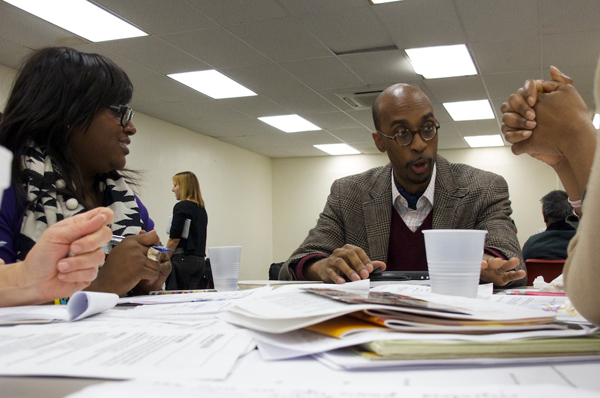
Photo by: Colin Weatherby
Allyson Martinez & Gene Johnson listen to project proposals at a recent District 45 participatory budgeting meeting
“What Would YOU Do with $1 Million Dollars?”
Councilman Jumaane Williams’ email blasts read like an award notice from Publishers Clearing House. He has signed a $1,000,000 check to fund the first democratically chosen capital project in New York City.
All his constituents need to do is decide what they want, which is turning out to be easier said than done. The participatory budgeting project has become a crash course in fiscal responsibility for everyone involved.
“It’s an excellent civics lesson. You say ‘Why hasn’t this project been done yet?’ Well, we are finding out why,” says Gene Johnson, a volunteer who has helped audit the proposals related to parks improvements. “This project is teaching us what red tape really means.”
The idea is simple enough: last summer four New York City Councilman were approached to test the new model and agreed to hand over a chunk of their discretionary funds for a vote by their constituency. The experiment began with a few local neighborhood meetings to spread the word and then the proposals started rolling in — hundreds of them. Volunteers are sifting through the ideas, and residents of the council members’ districts will vote March 30 to choose which proposals will become reality.
No shortage of ideas
In Williams’ district, Brooklyn College asked for solar panels. Elderly residents asked for security cameras. A church wants to have its roof repaired. The 273 proposals ranged from new garbage cans to a city-funded food cooperative. Proposals must ask for more than $35,000 in funding and less than $1,000,000. Roughly half were tossed out in recent weeks due to cost overruns, lack of feasibility and issues outside the councilman’s jurisdiction.
The bottom line is that a million dollars doesn’t buy very much in Brooklyn. Even a simple idea can require impact studies, permitting, and a bidding process that pushes the cost well over seven figures. Numerous road and sidewalk improvements became ineligible because capital funds can’t be used to fund Department of Transportation operations, Williams’ staffers said. Popular ideas that require ongoing staff support also had to be cut.
Constituencies have begun to develop around a handful of proposals. A coalition of about 20 cheerleaders, football players and track team members at Tilden High School pushed for lights on their football field —which they believe will cost about $200,000. The students are too young to vote, so they put together a Powerpoint and started knocking on doors to ask for community support.
“I’m getting used to people closing doors in my face,” says 16-year-old sophomore Shaina Williams. “It’s good practice.”
Process has benefits
The outreach process is a key component of the preparation for the upcoming vote. Grassroots organizing groups like Harlem-based Community Voices Heard and the Participatory Budgeting Project, a nationwide research group, have been providing free training to volunteers from all four districts. Volunteers are trying to encourage voter turnout and have spent many wintry evenings passing out stacks of pamphlets, explaining the voting process on street corners and drinking hot cocoa to stay warm.
“I think this has already been a huge success. I’ve really gotten to know some key players in my district and we’ve got a good idea of how to improve the process for next year,” says Williams, whose office has committed considerable manpower to the effort. Two interns and a new project coordinator were hired specifically to manage the neighborhood assemblies and proposal reviews. If the results of the voting are popular with constituents, he hopes to commit a larger portion of his roughly $5 million capital budget in the future.
The project has not been without conflict. A small faction of volunteers walked out of a meeting when their proposal for a community center was rebranded and resubmitted by a local non-profit organization. Participants have complained that it is difficult to craft a proposal without knowing how much various items cost. Several committee leaders say most of the problems have been resolved and many volunteers are of the mindset that the benefits of guaranteed results far outweigh the headache.
Hazel Martinez serves on several committees for the project and she is the president of a block association in East Flatbush. Her experience with city government has been less than positive.
“I’ve been going to the meetings for Community Board 14 for so many years and I never see the results of what they do. Frankly, I think it is a waste of time,” says Martinez. “I’ve met many new people in this project that I didn’t know and I think we all understand each other better now.”
Proponents of participatory budgeting hope that the four-district experiment will expand to more New York City neighborhoods next year. A similar program started two years ago in Chicago’s 49th Ward and has funded more than two-dozen civic improvements.








